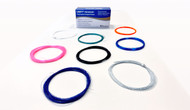Choosing the Right Suture Thread Material: Characteristics, Applications, Advantages and Disadvantages
Surgical sutures are essential for wound closure and facilitating tissue healing. These sutures come in a variety of materials, each with its unique properties, which offer distinct advantages and disadvantages. Read more about various absorbable and non-absorbable suture materials to help you choose the best suture material for your application.
Absorbable Suture Materials
Absorbable sutures are designed to gradually break down within the body, eliminating the need for removal. They are suitable for tissues requiring temporary support during the healing process.
1. PGA (Polyglycolic Acid) Sutures
PGA sutures are synthetic, rapidly absorbed within weeks. They offer excellent handling and knot security, making them suitable for short-term tissue support in surgeries like general surgery, urology, and gynecology.
2. PGCL (Polyglyconate) Sutures
Synthetic PGCL sutures are strong with low tissue reactivity. They find applications in various surgeries, such as general, gastrointestinal, and gynecological procedures.
3. Rapid PGA Sutures
An enhanced version of PGA sutures with faster absorption, they are ideal for superficial closures and subcutaneous tissue approximation, where quick absorption is needed.
4. PDO (Polydioxanone) Sutures
PDO sutures are synthetic and provide long-lasting absorbable support. They have minimal tissue reactivity and are often used in plastic and reconstructive surgery, particularly for skin closure.
5. Plain Gut Sutures
Made from natural collagen fibers, plain gut sutures are biocompatible and easy to handle. They are suitable for delicate tissues like those in mucosal and ophthalmic procedures.
6. Chromic Gut Sutures
Chromic Gut sutures are treated with chromium salts for delayed absorption, offering longer-lasting absorbable properties compared to plain gut. They are used in delicate tissues requiring extended support.
Non-Absorbable Suture Materials
Non-absorbable sutures remain intact and require removal. They are used in situations demanding long-term tissue support.
1. Silk Sutures
Silk sutures are made from natural silk fibers, soft, pliable, and easy to handle. They provide good knot security and are used in fields like ophthalmology and gastrointestinal surgery. However, they are non-absorbable and may provoke tissue reactions.
2. Nylon Sutures
Synthetic nylon sutures are strong, flexible, and easy to handle. They find versatility in various surgical fields, including plastic surgery and ophthalmology. However, they are non-absorbable and may cause inflammation if left in for extended periods.
3. Polypropylene Sutures
Polypropylene sutures, made of synthetic material, possess high tensile strength, minimal tissue reactivity, and versatility. They are commonly used in general surgery, cardiovascular surgery, and orthopedics. Yet, they are non-absorbable and may cause tissue indentation if tied too tightly.
4. Polyester Sutures
Polyester sutures, composed of synthetic material (polyethylene terephthalate), offer excellent strength and minimal tissue reactivity. They are used in general surgery and orthopedics but are non-absorbable and may provoke tissue reactions in rare cases.
5. Stainless Steel Sutures
Stainless steel sutures are made from medical-grade stainless steel, exceptionally strong, durable, and resistance to infection. They are primarily used in orthopedic and dental procedures, as well as for wound closure in high-tension areas. However, they are non-absorbable and may cause tissue irritation, requiring specialized instruments for removals.
6. PTFE (Polytetrafluoroethylene) Sutures
PTFE sutures are non-absorbable and crafted from a material known for its low friction and chemical resistance. They have applications in oral, cardiovascular and ophthalmic surgeries due to their biocompatibility and minimal tissue reactivity,
Choosing the optimal surgical suture material is a critical decision in surgical practice. Surgeons must carefully weigh the advantages and disadvantages of each suture material, considering the specific surgical procedure, tissue type, and the desired duration of tissue support. Understanding these characteristics empowers healthcare professionals to make informed choices, optimize patient outcomes, and minimize potential complications in surgical procedures

